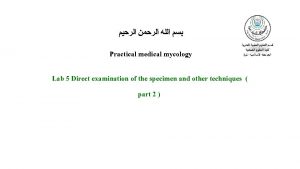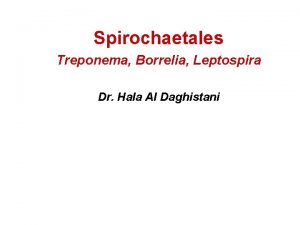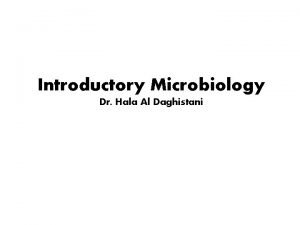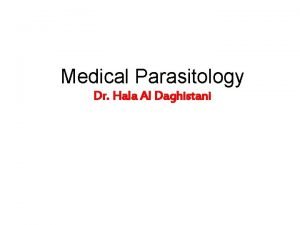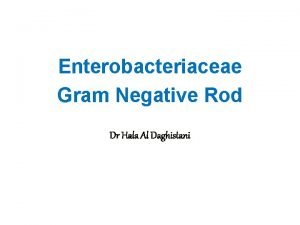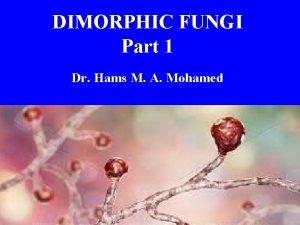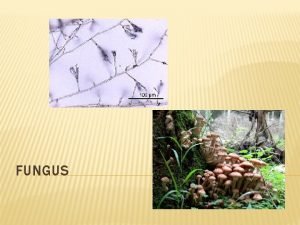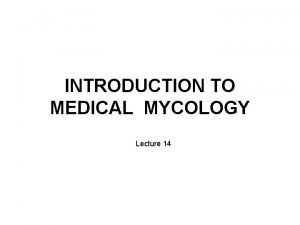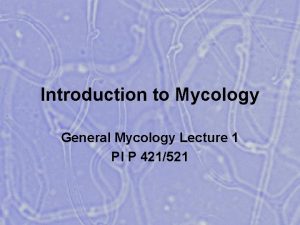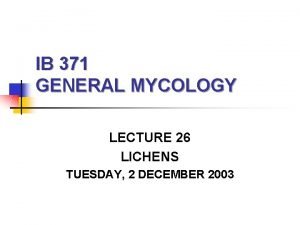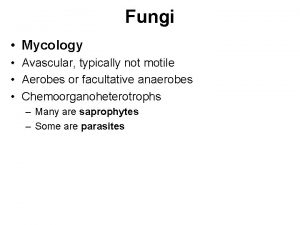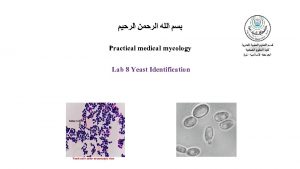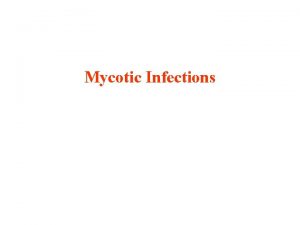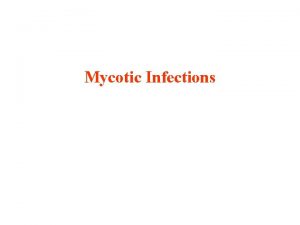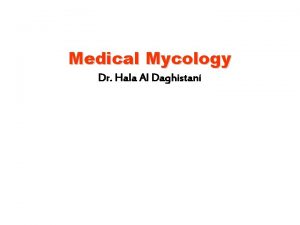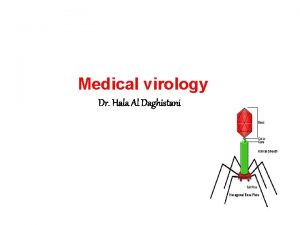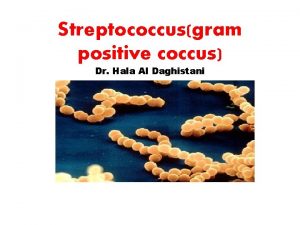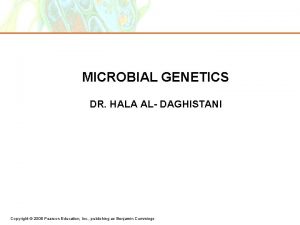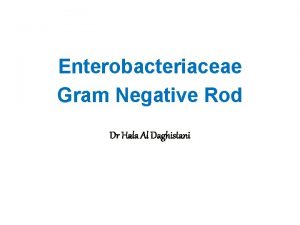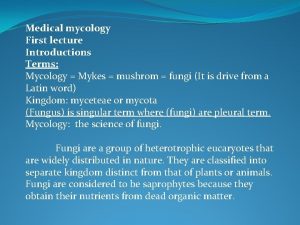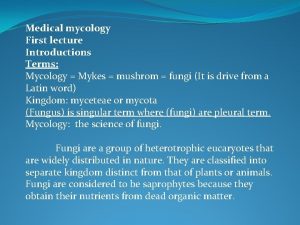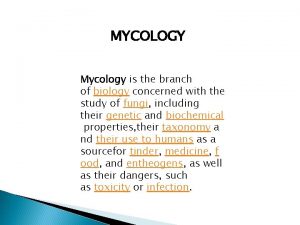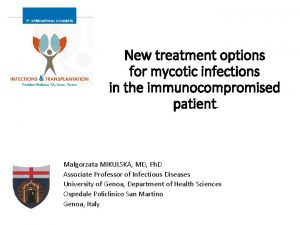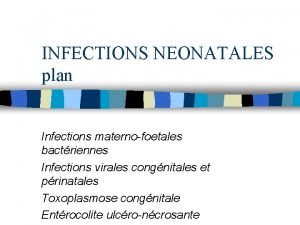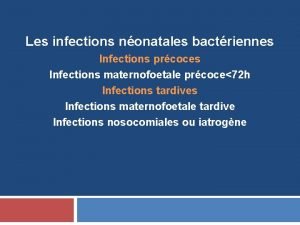Medical Mycology Dr Hala Al Daghistani Mycotic Infections






































- Slides: 38

Medical Mycology Dr. Hala Al Daghistani

Mycotic Infections GENERAL CONCEPTS A. The fungi represent a diverse, heterogeneous group of eukaryotic B. Most of these organisms are plant pathogens and relatively few cause disease in humans. C. The growth of the fungi generally involves two phases; Vegetative and Reproductive. D. Reproduce by means of spores, usually wind-disseminated E. both sexual (meiotic) and asexual (mitotic) spores may be produced, depending on the species and conditions F. typically not motile, although a few have a motile phase. .

• Most fungi exist as molds with hyphae but some fungi exist as unicellular yeast cells. • Some fungi can change their morphology and are termed dimorphic. For example, Candida is found in the yeast form at 37°C but changes to the mold form at 25°C. • In the reproductive phase, fungi may undergo either asexual or sexual reproduction. Asexual reproduction involves the generation of spores; sexual reproduction requires specific cellular structures that are used for taxonomic differentiation.

For the kingdom fungi, there are three phyla 1. Zygomycota (Rhizopus, Absidia, Mucor ) 2. Dikaryomycota ( further divided into two subphyla; Ascomycotina (Trichophyton, Histoplasma, Blastomyces) and Basidiomycotina (Cryptococcus) 3. Deuteromycotina ( fungi imperfecti )referring to "imperfect" knowledge of their complete life cycles (Candida, Epidermophyton, Coccidioides)

MYCOSIS CLASSIFICATION OF MYCOSES the clinical nomenclatures used for the mycoses are based on the (A) site of the infection (B) route of acquisition of the pathogen (C) type of virulence exhibited by the fungus. Classification based on site: Mycoses are classified as 1 - Superficial (are generally limited to the outer layers of the skin and hair. 2 - Cutaneous(are located deeper in the epidermis, hair and nails. 3 - Subcutaneous (involve the dermis, subcutaneous tissues and muscle). 4 - Systemic (deep) infections (generally originating in the lungs and other organs).

Classification based on route of acquisition infecting fungi may be either 1. Exogenous (routes of entry for exogenous fungi include airborne, cutaneous or percutaneous). 2. Endogenous (endogenous infection involves colonization by a member of the normal flora or reactivation of a previous infection). Classification based on virulence 1. Primary pathogens can establish infections in normal hosts. 2. Opportunistic pathogens cause disease in individuals with compromised host defense mechanisms.

Hypae (threads) making up a mycelium Yeasts Fungal Morphology Many pathogenic fungi are dimorphic, forming hyphae at ambient temperatures but yeasts at body temperature.

Classification of mycosis based on site A. Superficial Mycoses include the following fungal infections and their etiological agent: • Black piedra (Piedraia hortae), • White piedra (Trichosporon beigelii) • Pityriasis versicolor (Malassezia furfur) • Tinea nigra (Phaeoannellomyces werneckii)

Black piedra - is a superficial mycosis due to Piedraia hortae - is manifested by a small black nodule involving the hair shaft. White piedra - Due to Trichosporon beigelii - Is characterized by a soft, friable, nodule of the distal ends of hair shafts.

Pityriasis versicolor - is a common superficial mycosis - is characterized by hypopigmentation or hyperpigmentation of skin of the neck, shoulders, chest, and back. - is due to Malassezia furfur which involves only the superficial keratin layer. Tinea nigra - Due to Phaeoannellomyces werneckii Most typically presents as a brown-black silver nitrate-like stain - Appeared on the palm of the hand or soles of the foot.

black piedra White piedra Pityriasis versicolor

B. Cutaneous Mycoses involves deep epidermis and keratinized body areas (skin, hair, nails). Classified as A. Dermatophytoses (caused by the genera Epidermophyton, Microsporum, and Trichophyton) B. Dermatomycoses(the most common of which are Candida spp. ) - The Dermatophytoses are characterized by an anatomic site -specificity according to genera. for example *Epidermophyton floccosum infects only skin and nails, but does not infect hair shafts and follicles *Microsporum spp. infect hair and skin, but do not involve nails. *Trichophyton spp. may infect hair, skin, and nails.


Dermatomycoses



C. Subcutaneous Mycoses Involves dermis, subcutaneous tissues and muscle. There are three general types of subcutaneous mycoses: A. Chromoblastomycosis B. Mycetoma C. Sporotrichosis. All appear to be caused by traumatic inoculation of the etiological fungi into the subcutaneous tissue. * Chromoblastomycosis is a subcutaneous mycosis characterized by verrucoid lesions of the skin. - It is generally limited to the subcutaneous tissue with no involvement of bone, tendon, or muscle, the lower extremities. - The most common causes of Chromoblastomycosis are Fonsecaea pedrosoi, Fonsecaea compacta, Cladosporium carionii.

Mycetoma is a suppurative and granulomatous subcutaneous mycosis, which is destructive of contiguous bone, tendon, and skeletal muscle. - It is characterized by the presence of draining sinus tracts from which small but grossly visible pigmented grains or granules are extruded. - The causes of Mycetoma are more diverse but can be classified as Eumycotic and Actinomycotic mycetoma.

Sporotrichosis - This infection is due to Sporothrix schenckii and involves the subcutaneous tissue at the point of traumatic inoculation. - The infection usually spreads along cutaneous lymphatic channels of the extremity involved.

D. Deep Mycoses Primary versus Opportunistic mycoses - The Primary pathogenic fungi are able to establish infection in a normal host; whereas, Opportunistic pathogens require a compromised host in order to establish infection (e. g. , Cancer, Organ transplantation, Surgery, and AIDS). - Primary deep pathogens usually gain access to the host via the respiratory tract. - Opportunistic fungi causing deep mycosis invade via the Respiratory tract, Alimentary tract, or Intravascular devices.

Primary Systemic fungal pathogens include: Coccidioides immitis (Coccidioidomycosis ), Histoplasma capsulatum (cave disease), Blastomyces dermatitidis (Blastomycosis), Ø Originate in lungs, phagocytosis by macrophages, spread to many organs. Ø Most primary infections are inapparent. Ø Progression may produce pulmonary symptoms or ulcerative lesions. Ø Host responses produce formation of fibrous tissue, granulomas and calcified lesions. Ø Normally found in soil, these organisms infect via inhalation

ØHistoplasmosis is characterized by intracellular growth of the pathogen in macrophages and a granulomatous reaction in tissue. - These granulomatous foci may reactivate and cause dissemination of fungi to other tissues. - Usually, acute benign respiratory disease - Rarely, progressive, chronic or disseminated disease

ØSystemic Mycoses are generally Asymptomatic but may have generalized symptoms including : low grade fever, shaking chills, night sweats, malaise or appetite loss.

Opportunistic Fungal pathogens include: Cryptococcus neoformans, Candida spp. (Candidiasis), Aspergillus spp. (Aspergillosis), Penicillium marneffei, Zygomycetes (Zygomycosis), Trichosporon beigelii. - These organisms generally have a low potential for virulence but can produce severe disease involving a variety of body tissues.

PATHOGENESIS: Mycotic disease is often a consequence of predisposing factors including 1. Age 2. Stress 3. Other pathologic conditions (e. g. cancer, diabetes, AIDS).

C. albicans is a member of the indigenous microbial flora of humans. 1. Found in the gastrointestinal tract, upper respiratory tract, buccal cavity, and vaginal tract. 2. Growth is normally suppressed by other microorganisms found in these areas. 3. Alterations of gastrointestinal flora by broad spectrum antibiotics or mucosal injury can lead to gastrointestinal tract invasion. 4. Skin and mucus membranes are normally an effective barrier but damage by introduction of catheters or intravascular devices can permit candida to enter the bloodstream. in vitro (25 o c): mostly yeast; in vivo (37 o c): yeast, hyphae and pseudohyphae


ØVaginal Candidiasis (vaginal thrush) is the most common clinical infection. local factors such as ph and glucose concentration (under hormonal control) are of prime importance in the occurrence of vaginal candidiasis. in mouth: normal saliva reduces adhesion (lactoferrin is also protective). Risk factor for candidiasis 1. Post-operative status 2. Cytotoxic cancer 3. Chemotherapy 4. Antibiotic therapy 5. Burns 6. Drug abuse 7. Gastrointestinal damage.

Fungi generally cause one of three distinct tissue responses; Chronic inflammation (Scarring, accumulation of lymphocytes) Granulomatous inflammation (Collections of modified epithelial cells, lymphocytes) Acute Suppurative inflammation (vascular congestion, exudation of plasma, accumulation of PMNs)

Ø Some of the tissue responses may be due to Mycotoxins, which are fungal metabolites that are toxic to the host. Ø Some agents produce LPS-like endotoxins or Hemolysins or Steroid-like toxins that affect the nervous system Ø Aspergillus produces a toxin called Aflatoxin that has a strong association with liver cancer.

AFLATOXIN: When contaminated food is processed, Aflatoxins enter the general food supply where they have been found in human foods as well as in feedstocks for agricultural animals. - At least 14 different aflatoxins are produced in nature. - Aflatoxin b 1 is considered the most toxic - Animals fed contaminated food can pass Aflatoxin into eggs, milk products, and meat. - Contaminated poultry feed is suspected in the findings of high percentages of samples of Aflatoxin contaminated chicken meat and eggs

Children are particularly affected by Aflatoxin exposure, which leads to stunted growth, delayed development, liver damage, and liver cancer. Adults have a higher tolerance to exposure, but are also at risk. Aflatoxins are among the most carcinogenic substances known.

HOST DEFENSES: Host defenses against the fungi include nonspecific and specific factors Nonspecific defenses include 1. the skin (lipids, fatty acids, normal flora) 2. Internal factors (mucous membranes, ciliated cells, macrophages) 3. Blood components 4. Temperature 5. Genetic 6. Hormonal factors. .

Specific defenses include both A. Humoral (antibodies may be protective (e. g. antitoxins or opsonins). B. Cell-mediated. Generally, cell-mediated defenses are probably more important. Acquired resistance is usually T-cell mediated and persons with compromised cellmediated defenses generally show more disseminated disease

EPIDEMIOLOGY Dermatophytes may be communicated from person to person by combs, towels, etc. Candida is a member of the normal vaginal flora; candidiasis is often associated with diabetes. In some cases of mycosis, Occupation seems an important contributor. For example, Sporothrix is normally found in woody plants; hence, agricultural workers acquire disease more often. Similarly, Histoplasma is often found in bird or bat excret; hence caves workers or persons involved in community clean up may acquire more often.

DIAGNOSIS Clinical: For the dermatophytes, appearance of the lesions is usually diagnostic. For systemic mycoses, the epidemiology and symptomology are useful Samples include: scrapings of scale, hair which has been pulled out from the roots, brushings from an area of scaly scalp, nail clippings, or skin scraped from under a nail, skin biopsy, moist swab from a mucosal surface (inside the mouth or vagina) in a special transport medium. Laboratory: Treatment of skin scrapings with 10% potassium hydroxide can reveal hyphae or spores. Most fungi can be grown on Sabouraud's dextrose agar but they are often very difficult to speciate. Skin testing for a delayed hypersensitivity response is useful for epidemiologic purposes but often not for diagnosis.

Germ tube test Is a screening test which is used to differentiate candida albicans from other yeast. When candida is grown in human or sheep serum at 37°c for 3 hours, they forms a germ tubes, which can be detected with a wet films as filamentous outgrowth extending from yeast cells. It is positive for candida albicans.

CONTROL Sanitary: Control by sanitary means is difficult, but the incidence of communicable disease can be reduced by good hygiene. Immunological: No vaccines are currently available. Chemotherapeutic: Many antifungals are available but some are very toxic to the host and must be used with caution. Topical powders and creams often contain azole derivatives (miconazole, clotrimazole, econazole) are useful against superficial dermatophytes. Sporotrichosis may be treated using potassium iodide Systemic infections are generally treated by 5 - FC, miconazole, Fluconazole or ketoconazole.
 Keisya nawrah md rizal
Keisya nawrah md rizal Mycotic infection rabbit
Mycotic infection rabbit Tease mount method
Tease mount method Mycology classification
Mycology classification Dr daghistani
Dr daghistani Dr al daghistani
Dr al daghistani Dr al daghistani
Dr al daghistani Swarming proteus
Swarming proteus Blastomyces dermatitidis
Blastomyces dermatitidis Industrial mycology
Industrial mycology Mycology is the study of
Mycology is the study of Mycology
Mycology Mycology
Mycology Mycology
Mycology Glomerulomycota
Glomerulomycota Yeast unicellular or multicellular
Yeast unicellular or multicellular Fungi singular
Fungi singular Mycology lecture
Mycology lecture Introduction of mycology
Introduction of mycology Mycology lecture
Mycology lecture Mycology
Mycology Mycology
Mycology Lichen as food
Lichen as food Candida albicans germ tube test
Candida albicans germ tube test Postpartum infections
Postpartum infections Opportunistic infections
Opportunistic infections Salmonella life cycle
Salmonella life cycle Johnson and johnson botnet infections
Johnson and johnson botnet infections Bone and joint infections
Bone and joint infections Retroviruses and opportunistic infections
Retroviruses and opportunistic infections Methotrexate and yeast infections
Methotrexate and yeast infections Acute gingival infections
Acute gingival infections Storch infections
Storch infections Neurosiphyllis
Neurosiphyllis Genital infections
Genital infections Opportunistic infections
Opportunistic infections Bacterial vaginosis
Bacterial vaginosis Amber blumling
Amber blumling Chapter 25 sexually transmitted infections and hiv/aids
Chapter 25 sexually transmitted infections and hiv/aids


